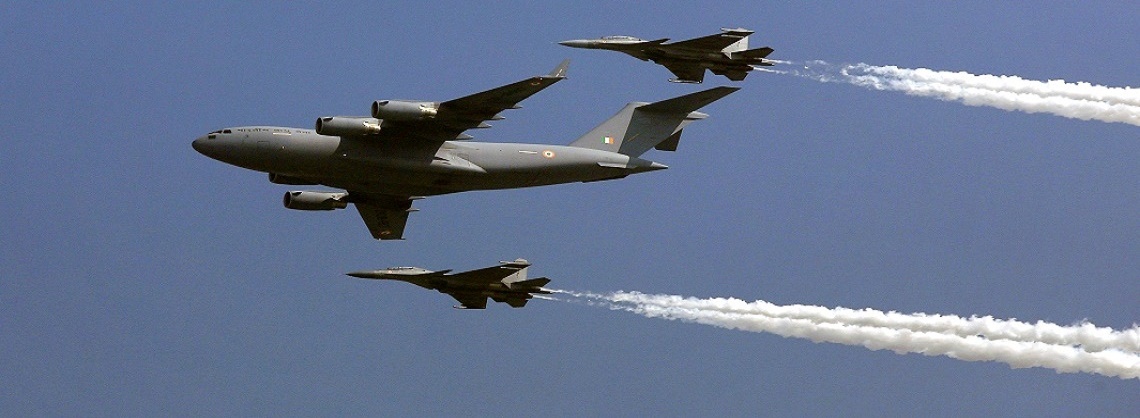Image courtesy Indian Air Force website
“Although the Indian armed forces have the fiery spirit for winning wars, yet a conventional deterrence value is essential while facing a dual threat along its borders. Depleted Force Levels is indeed not a situation we should continue to be in for a prolonged period. Hence, IAF needs to fill the gap with additional numbers as, it is said ‘Quantity has a quality of its own!’ Diplomacy is of high priority for mending relationships, yet firm diplomacy can succeed more effectively when backed by a robust military capability. It is, therefore, in the overall interests of the nation that air power, being the ‘weapon of first choice’ during conflict, is maintained at a level which deters our adversaries to initiate any aggressive action”, says Air Marshal Ajit Bhavnani, PVSM, AVSM, VM(G), (Retd).
The author, who is Former Vice Chief of Air Staff & Founder Member – Society for Aerospace, Maritime and Defence Studies (SAMDeS), writes about the urgency in adding vigour to India’s airpower in the background of Indo-China and Indo-Pak standoffs along the borders.
After several months of eyeball to eyeball stand-off between Indian and Chinese forces in Eastern Ladakh, the process of gradual albeit limited disengagement has now begun. Yet we cannot lose sight of the “unilateral and provocative” aggressive action taken by China to change the status quo on the Line of Actual Control (LAC). While Indian forces responded firmly to thwart this aggressive land grab action, it reflects China’s enduring belligerent designs, given that such an unwarranted offensive action occurred at a time when the entire world was grappling with the COVID-19 pandemic ; clearly a sign of China’s larger strategic agenda. It is indeed significant to note that this unprovoked offensive by China did not rattle India’s leadership, and Indian forces stood up squarely and responded in a robust and muscular manner. Although the appropriate message has been conveyed by India, it will be prudent to remain cautious and refrain from lowering our guard against China.

Expectedly, when the stand off began in Eastern Ladakh, China’s foreign office spokesman Zhao Lijian blamed India for the on-going border stand-off and added, “First, I want to make it clear that China does not recognise the Ladakh Union Territory illegally set up by the Indian side and also Arunachal”.
At the same time, China continues to brazenly support Pakistan’s stand on Kashmir despite the relentless designs by Pak to destabilise Kashmir with its state sponsored terrorism.
Recent intelligence reports also indicate China’s infra build up on the border with Arunachal and Sikkim.
During the month of December 2020, air forces of Pakistan and China conducted a three-week long joint combat exercise – Shaheen-IX at an air base in Pakistan. Speaking at the inaugural, PAF’s Deputy Chief of Air Staff Operations emphasized the “increased level of combat training” and added, the exercise was “designed to deepen cooperation and enhance interoperability of both Air Forces, thereby fortifying the brotherly relations between our two countries”.
On 01 January 2021, in accordance with a new law, Chairman of China’s Military Commission, Xi Jinping was given full powers to mobilize military and civilian assets to defend national interests, both within China and abroad. According to a recent CNN report, Xi Jinping has called on troops to “put all their minds and energy on preparing for war”.

We need not read too far between the lines to be convinced that the stated emphasis on “enhanced Interoperability” being the primary objective for “increased level of combat training”, underlines the possibility of collusive plans for a coordinated future conflict with India.
Ample indications are now available to conclusively assess the possibility of joint action by China and Pakistan in the event of conflict with India. In recent years, successive Service Chiefs have warned the Govt on the challenging security situation considering that a two-front war has now become more of a reality than ever before.
In the current global battle scenario, Land and Naval forces would continue to play a predominant role and are moving forward providing greater destructive power with higher mobility.
No matter whether the action is on land or at sea, Air Power is an inescapable element in the successful design of battle. Air Power is a force multiplier and provides a quantum leap in capability with innovative utilization of modern sensors and new weapon systems delivering long range, high precision targeting with high kill probability.
In the recent past, conflicts have shown air power providing unique capabilities, thus giving the advantage needed at the outset of conflict. Lt Gen Dave Deptula, Retd, (USAF), Dean of Mitchell Institute for Aerospace Studies, puts it aptly “Precision and speed create mass of their own. Airpower can now help ‘control’ an adversary instead of simply destroying fielded forces or support an army”.
Therefore, effective use of air power with swift and intensive lethal action can provide the military advantage for creating favourable outcomes in conflict.

We can gauge the “shock and awe effect” of air power by the manner in which IAF achieved total surprise during the night air strike over Balakot in February 2019. IAF’s success of the air strike was evident by the manner in which it completely jolted the Pakistani leadership, who called for immediate revenge. The fact that their riposte with PAF air strike targeting Indian Army ground targets went nowhere, is another story!
Continued in Part 2 ::::: : : :
